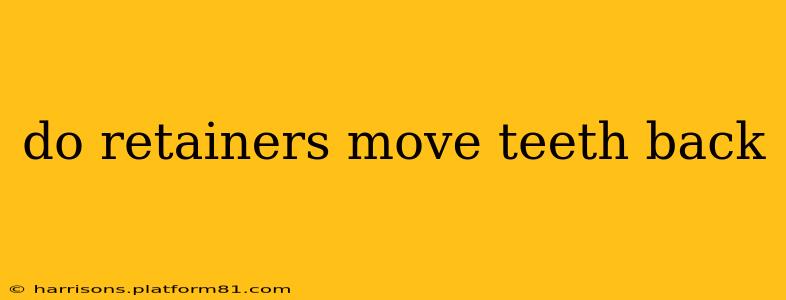Do Retainers Move Teeth Back? Understanding Retainer Function and Tooth Movement
Retainers are an essential part of orthodontic treatment, playing a crucial role in maintaining the straight smile achieved through braces or aligners. While their primary function is maintaining the position of your teeth, they can cause minor tooth movement, albeit usually not in a significant way. Let's delve into the specifics.
Can retainers move teeth significantly?
No, retainers are not designed to significantly move teeth back or make major adjustments to your bite. They are primarily designed to prevent teeth from shifting back to their original positions after orthodontic treatment. The amount of force a retainer applies is significantly less than that of braces or aligners. Any movement you experience is usually minor and should be addressed with your orthodontist.
What type of tooth movement can retainers cause?
The type and degree of tooth movement a retainer might cause are highly variable and depend on several factors, including:
-
Type of retainer: Fixed retainers (bonded to the back of your teeth) are much less likely to cause significant movement than removable retainers (Hawley retainers, Essix retainers, etc.). Removable retainers, if not worn consistently, can allow teeth to shift. However, even with consistent wear, minor drifting might still occur.
-
Material: The material of the retainer also plays a role. Some materials are more flexible and less likely to exert significant force.
-
Compliance: The most significant factor affecting any tooth movement with a retainer is patient compliance. Consistent and proper wear is crucial for maintaining the results of orthodontic treatment. If a retainer is worn inconsistently, teeth can drift.
-
Time since treatment: Immediately after braces are removed, teeth are more prone to shifting. Over time, the teeth become more stable, and the risk of significant movement decreases.
What if my retainer feels loose or my teeth feel like they're shifting?
If your retainer feels loose or if you feel like your teeth are shifting after orthodontic treatment, it's vital to contact your orthodontist immediately. This isn't normal, and they can assess the situation, make necessary adjustments (e.g., replacing or refitting your retainer), and address any underlying issues.
How long should I wear my retainer?
The length of time you need to wear your retainer depends on individual factors and your orthodontist's recommendations. Some individuals may need to wear their retainer indefinitely, while others may transition to wearing it only at night. Your orthodontist will provide personalized advice based on your specific case. Ignoring this advice can lead to teeth shifting.
What are the signs that my teeth are shifting?
Signs that your teeth might be shifting include:
- A retainer that feels loose or doesn't fit properly.
- Teeth that feel crowded or misaligned.
- Changes in your bite (e.g., difficulty chewing or a noticeable change in how your teeth come together).
- Increased sensitivity or discomfort in your teeth and gums.
In summary: While retainers aren't designed for significant tooth movement, minor shifts can occur, especially with inconsistent wear of removable retainers. Regular check-ups with your orthodontist, and consistent retainer use, are crucial to maintain your straight smile long-term. Always communicate any concerns about your retainer or teeth to your orthodontist promptly.
